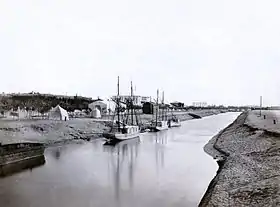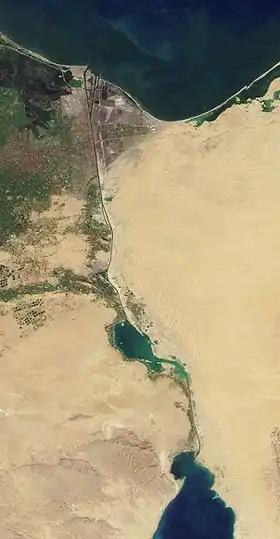Sweet Water Canal
Sweet Water Canal, also known as Fresh Water Canal and currently known as Ismaïlia Canal, is a canal which was dug by thousands of Egyptian fellahin to facilitate the construction of the Suez Canal. The canal travels east-west across Ismailia Governorate.[1]
| Sweet Water Canal | |
|---|---|
 | |
| Specifications | |
| Status | Open |
| History | |
| Construction began | 1861 |
| Date completed | 1863 |
| Geography | |
| Start point | Zagazig |
| End point | Lake Timsah |
It was dug to provide fresh water to the arid area, from Lake Timsah to Suez and Port Said.[2][3](p267)[4] The canal facilitated the growth of agriculture settlements along the Suez Canal, and it is particularly important for supplying water to the city of Port Said. Like the Suez Canal, it was designed by French engineers; construction lasted from 1861 until 1863. It runs through the now-dry distributary of the Wadi Tumilat,[5] incorporating portions of an ancient Suez Canal that existed between Old Cairo and the Red Sea.[3](pp251–257)
Construction
In February 1862, after thousands of workers excavated 1.1 million cubic meters, the canal reached Lake Timsah. As soon as the fresh water reached the area, more labourers were hired for the Suez Canal construction project. The canal also allowed for the easy transportation of materials and food with ferries traveling along its narrow ways.[2][6]
Battle of Kassassin Lock
The Battle of Kassassin Lock was fought near Sweet Water Canal, on August 28, 1882.[7]
Anglo-Egyptian War
Less than 100 years later, the canal[8] no longer provided clean, fresh water but was disturbingly polluted. During the 1950s when British soldiers were stationed in the area, some referred to the canal as an open sewer. Royal Air Force personnel were advised to avoid contact with the water and were warned that the canal was where deserters would end up.[9] When the war became especially bloody, between national, Egyptian, resistance movements and British soldiers, from October 1951 to January 1952, the remains of some of the British soldiers who were tortured and killed, ended up in the canal.[4][10][11]
See also
References
- "Al-Ismailiyyah". Britannica. Archived from the original on 19 October 2016. Retrieved 20 November 2016.
- Karabell, Zachary (2003). Parting the Desert: The Creation of the Suez Canal. A.A. Knopf. p. 172. ISBN 9780375408830. Retrieved 19 November 2016.
British servicemen, sweet water canal.
- Rappoport S. "Chapter V: "The Waterways of Egypt"". History of Egypt (Project Gutenberg). Volume 12, Part B. London: The Grolier Society. Archived from the original on 2017-08-01. Retrieved 11 March 2013.
- Smith, Simon C. (2016). Reassessing Suez 1956: New Perspectives on the Crisis and Its Aftermath. Routledge. p. 16. ISBN 9781317070696. Retrieved 19 November 2016.
- Encyclopædia Britannica, 11th edition, s.v. "Suez Canal" Archived 2016-11-19 at the Wayback Machine. Accessed 19 November 2016.
- "Photo of ferry in canal". Suez Canal Zone. Archived from the original on 8 April 2016. Retrieved 20 November 2016.
- Arthur, Sir George (1909). The story of the Household Cavalry. London,: A. Constable. pp. 676–679. Retrieved 21 November 2016.
- Woolley, Richard (Dick). "Suez Canal Zone Map". Suez Canal Zone. Archived from the original on 2 November 2016. Retrieved 20 November 2016.
- Richards, Colin (November 3, 2012). New Skeletons (2nd ed.). Colin Archer-Richards. ISBN 9781291925623. Retrieved 19 November 2016.
- Delta, Charlie. "Photos of the Sweet Water Canal in the 1950s". Suez Canal Zone. Archived from the original on 2016-10-29.
- Tait, James H. (21 November 2012). One Day At A Time: My Lfe And Times (Ch. 41 Service in Suez). AuthorHouse. ISBN 9781456793029. Retrieved 20 November 2016.
